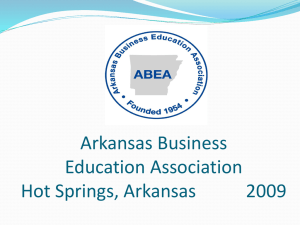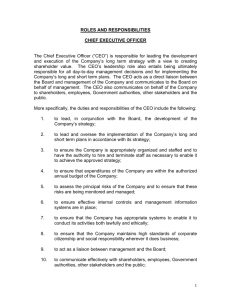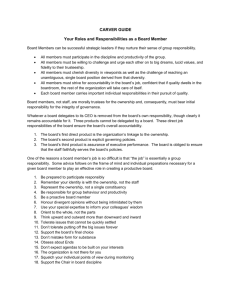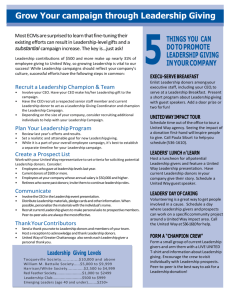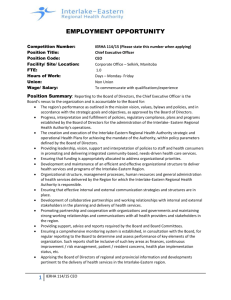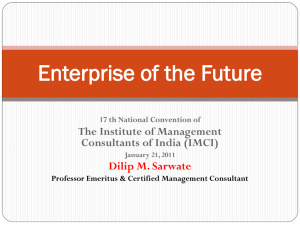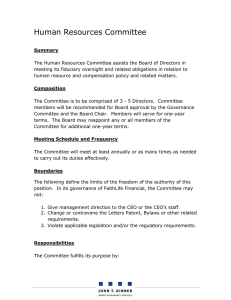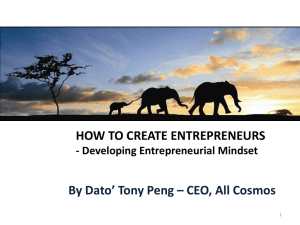FUND DEVELOPMENT AND BOARD LEADERSHIP
advertisement
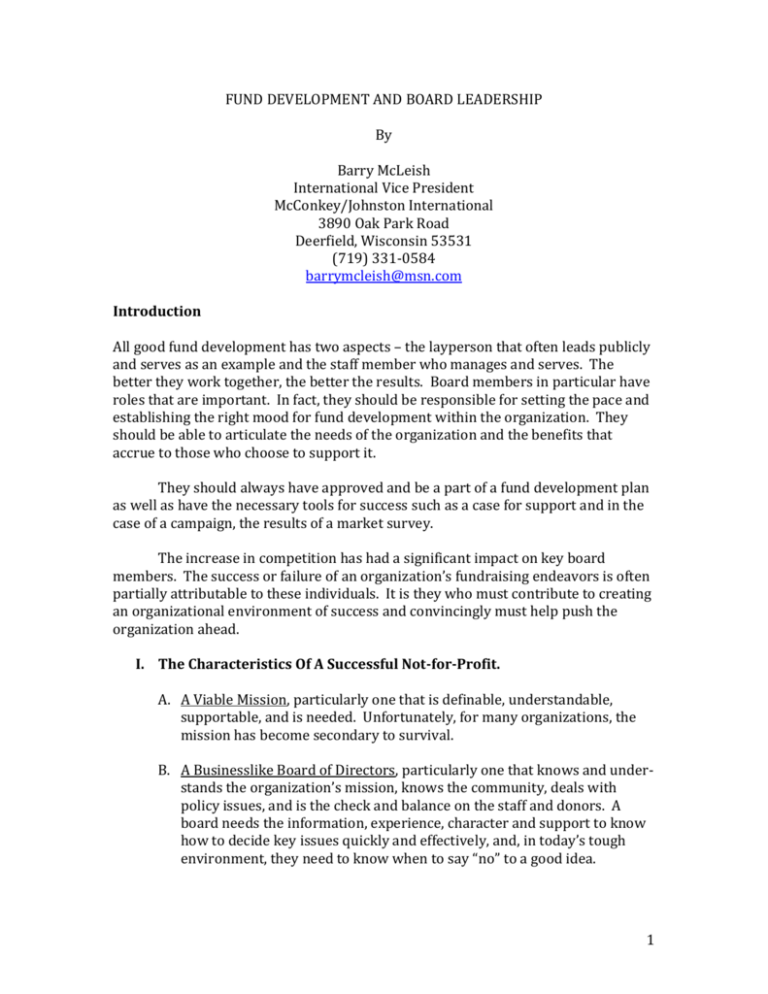
FUND DEVELOPMENT AND BOARD LEADERSHIP By Barry McLeish International Vice President McConkey/Johnston International 3890 Oak Park Road Deerfield, Wisconsin 53531 (719) 331-0584 barrymcleish@msn.com Introduction All good fund development has two aspects – the layperson that often leads publicly and serves as an example and the staff member who manages and serves. The better they work together, the better the results. Board members in particular have roles that are important. In fact, they should be responsible for setting the pace and establishing the right mood for fund development within the organization. They should be able to articulate the needs of the organization and the benefits that accrue to those who choose to support it. They should always have approved and be a part of a fund development plan as well as have the necessary tools for success such as a case for support and in the case of a campaign, the results of a market survey. The increase in competition has had a significant impact on key board members. The success or failure of an organization’s fundraising endeavors is often partially attributable to these individuals. It is they who must contribute to creating an organizational environment of success and convincingly must help push the organization ahead. I. The Characteristics Of A Successful Not-for-Profit. A. A Viable Mission, particularly one that is definable, understandable, supportable, and is needed. Unfortunately, for many organizations, the mission has become secondary to survival. B. A Businesslike Board of Directors, particularly one that knows and understands the organization’s mission, knows the community, deals with policy issues, and is the check and balance on the staff and donors. A board needs the information, experience, character and support to know how to decide key issues quickly and effectively, and, in today’s tough environment, they need to know when to say “no” to a good idea. 1 C. Strong, Well-Educated Staff And Board, ones who are advocates for “the Mission,” who manage the organization, and who are constantly getting trained. There is no investment more necessary and more neglected than staff and board training. D. A Tight Set of Controls, including personnel (board and staff), finance, operations, maintenance and quality control. Good controls free an organization to work. E. A Bias For Marketing and Fund Development, understanding that everything they do is marketing and who see every act from service provision to how the phone is answered, as marketing and fund development opportunities that can be pursued. F. A Vision For Where The Organization Is Going; so simple yet so often ignored. A strategic plan and a fund development plan are keys to success. Without a plan, the only way you get anywhere is by accident. G. Financial Empowerment, means that organizations need to think about where their income is going to come from so as to not be tied to just a few donors or foundations. Ultimately, we want the ability to impact a mission without having to wait for help. H. Social Entrepreneurs, particularly those who are willing to take risks to perform their mission; to try (and often fail) and try again; to look at markets and provide services to support their mission rather than create bureaucracies to continue past – and often outdated – practices. I. Rapid Response To Changing Circumstances. It is always good to ask, “How many of our services were we providing in the same way (same time, same place, same method) as five years ago?” II. Fund Development – More Than Fund Raising. A commitment to gaining resources for an organization is a commitment to more than simply fund raising. It is a determination to secure a healthy future for the organization by providing adequate resources to fuel the organization’s current mission objectives and to pursue the vision of its leadership. To be successful in fund development, the involvement of the Board of Directors is paramount. Involvement begets investment. A. The board is needed in this endeavor in a number of ways: 1. Helping to set fundraising (or campaign) goals. 2. Encouraging the staff in their efforts and providing practical counsel. 2 3. Helping to formulate plans for fund development. 4. Identifying, cultivating, and soliciting prospects that the staff will have a hard time either approaching or making contact with. 5. Accept posts in a capital campaign. B. Practically, the board can: 1. Make gifts that are generous and appropriate to their means. 2. Become a soliciting volunteer to make calls with other board members, staff and executive director, or on your own. 3. Work to bring other volunteers into the organization. 4. Communicate to others about their soliciting intent. 5. Develop a public relations posture on behalf of the organization. C. The Board of Directors may consider: 1. Having a development project that is uniquely theirs. 2. Providing board training on development tactics and asking. 3. Make some calls with the development officer and/or the executive director. 4. Hosting private events (dinner at a home or at a club) as opposed to hosting big events like golf tournaments. III. Board Members Who Raise Money Share Some Characteristics. A. They have a natural relationship with or commitment to the institution. B. Willingness to contribute. C. Willingness to use the appropriate method of asking and thus persuade others to give. D. Enough interest in the institution to ask hard questions and ensure that the staff members carry out their administrative responsibilities. E. A sense of passion about the institution and its mission, and a willingness to become advocates on its behalf. F. Thorough knowledge of the institution, including its past and present, its traditions and values, and the likely direction of its future. IV. Board Members Need A Chief Executive Officer Who Does The Following: A. Apart from all the normative stuff that you read a CEO should do such as “personify the character and the goals of the institution being led,” board members also need: 3 1. A CEO who can tell the institution’s story in such a way as to draw individuals to him or her. 2. The CEO must communicate these goals to the institution’s constituency on a repeated basis. 3. The CEO must create strong development culture, staff, and board participation. 4. The CEO must be primarily responsible for fund raising – how he or she accomplishes this will vary from institution to institution and will depend on the personality of the CEO and their style of operation. This does not mean the CEO cannot get a lot of help from others; in fact, without this, the operation will likely fail. V. Critical Questions Board Members Have About Fund Development. A. Will the Institution train me if I need training? Particularly in phrasing the request, which will take the sting out of making the request? B. Are key staffs and the CEO willing to help me make calls should I need it? C. How much time are we talking about? D. Describe the goals and how they were set. Are they obtainable? E. Which types of prospective donors will be most suitable to me given my background, religious affiliation, where I work and what I do? F. If I am calling on people I do not know, can you give me any background on them in writing, particularly their past – if any – relationship with the Institution? V. A Board Member Who Is A Solicitor Needs The Following Before They Make A Call. A. They should know what the organization’s case for support is, know it concisely and be able to speak about it enthusiastically. B. They should make their own gift before they make a call. It gives them a a psychological boost and helps them ask others. C. Rehearse so that the solicitor is positive and not apologetic. Assume that the prospect is going to give something. D. Make personal calls only. See prospects on a face-to-face basis; do not use telephone calls or letters except to arrange or confirm meetings. 4 E. Keep your sights high. On the first visit ask a question that is open-ended that you can come back and talk to the prospect about. F. See the prospect again. Decisions for gifts take time. Do not leave a pledge card. Be prepared to make a number of visits if you need to. G. Get the job done. Do not procrastinate. Take the best prospects first. success will build your confidence. H. Do not be afraid to make calls with someone else. It will bolster your confidence. 5

